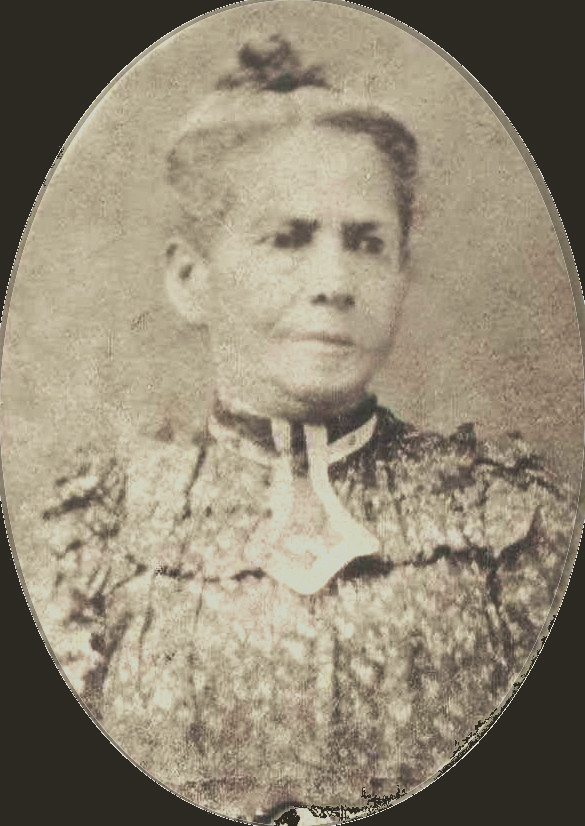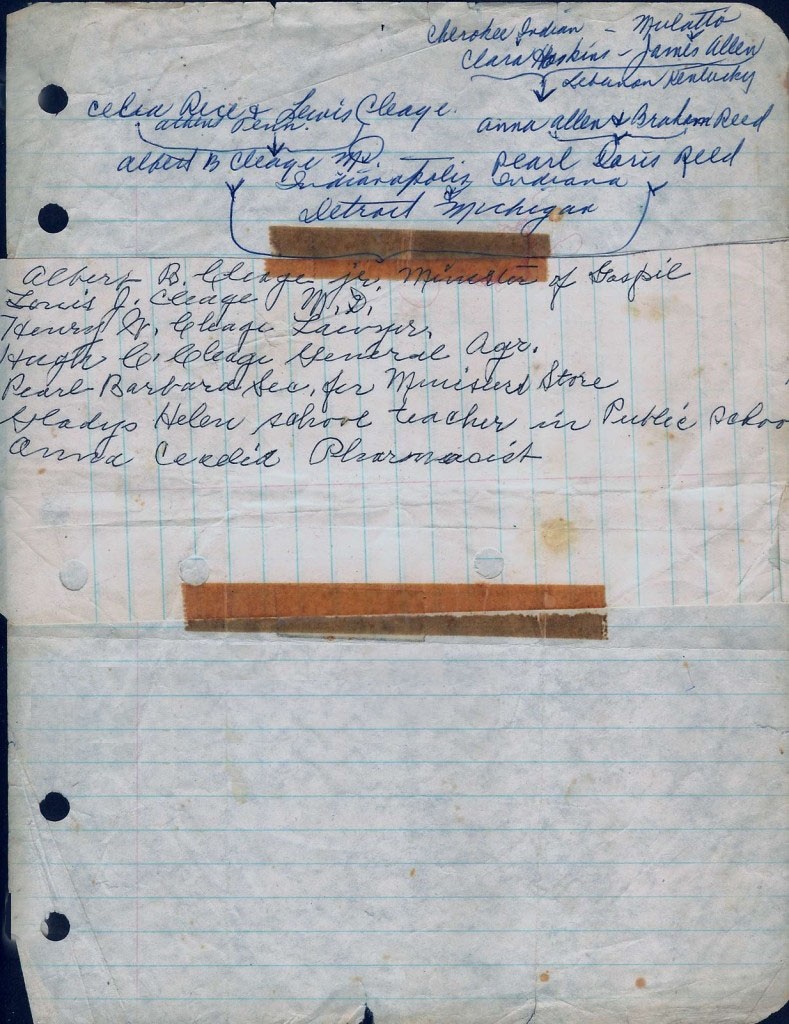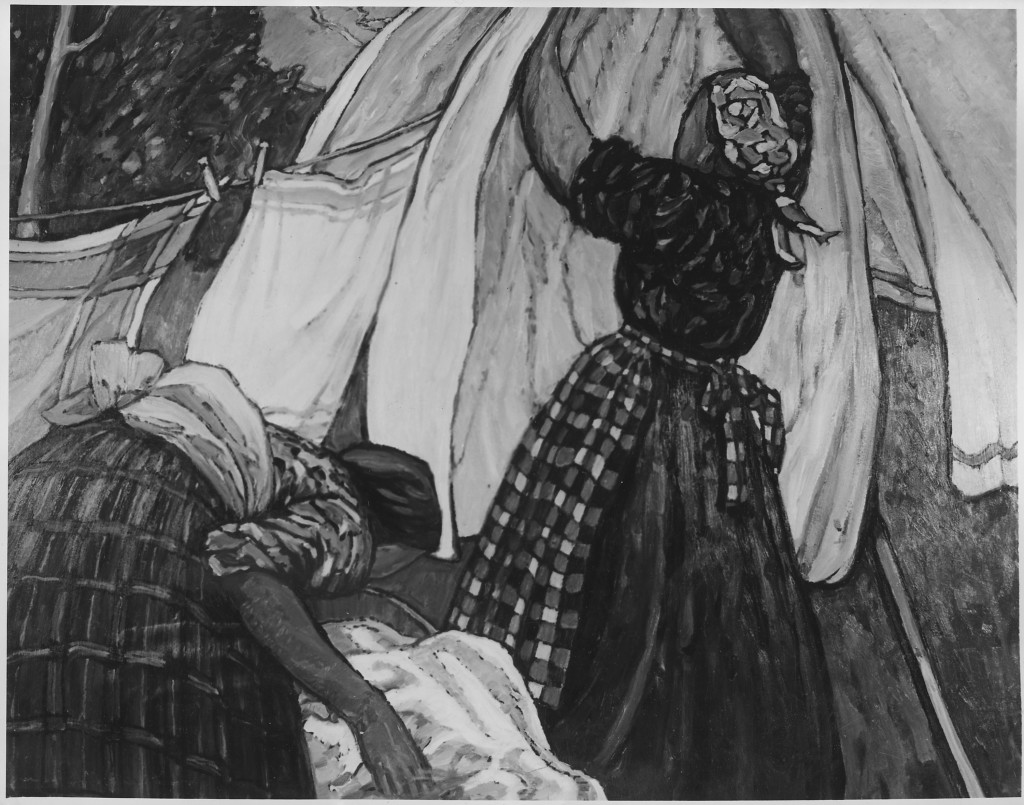This is my first post for the April A-Z Challenge. I will be blogging everyday using the letters of the alphabet as a prompt. Today I am going to write about one of my great grandmothers, Anna Allen Reed.
Anna Allen Reed was my father’s mother’s mother. I don’t have any photographs of her but my grandfather said that my Aunt Gladys looked just like her grandmother and that Anna Reed was the meanest woman in the world.


When I started asking for information about the family and tracing my grandparent’s family in the 1970s, my grandmother Pearl Reed Cleage sent me a paper on which she had written her parents and grandparents on the right hand side and her husband’s on the left. She listed their children and their professions below. Scotch tape held the two papers together. Although she always said her grandmother, Clara was a Cherokee Indian, there is no evidence to support this. The mtDNA test that my Aunt Gladys took that goes back through the material line is L3e2a1b1, which goes back to Northeast or Central Africa. I also cannot find the family before 1870 which indicates, to me, that they were probably enslaved. They are listed in the censuses as “mulatto” or “Black” or “Negro”, depending on year and location. Anna was Catholic and raised her children as Catholics.
In 1870 twenty five year old Anna was living with her 3 year old son, George and working as a cook in a household in Lebanon, KY. Her maiden name was listed on several of her children’s documents as “Ray”. On others it was listed as “Allen”. In 1870, her oldest daughter, Josephine, lived with Clara and James Greens. By 1880 Anna Reed was living with 6 of her 8 children, next door to Clara and James Green. She was supporting her family as a “laundress”.
According to Sharecropping, Laundry, and Black Labor in the New South, “Black laundresses were … in great demand in southern Jim Crow society. Because of the widespread call for their services, laundresses could, in some cases, manage to exercise some small degree of independence. They could, for example, choose to do laundry four to six days a week, depending on how many households they chose to serve. But economic necessity usually dictated that number, and the washerwomen were usually obligated to work as much as possible. Laundresses made $4 to $8 a month, and theirs was one of the hardest possible domestic trades; the more clothes that people accumulated in the post-industrialized clothing boom of the late nineteenth and early twentieth centuries, the more work was left for the washing women. These women desperately needed the income … They had to make their own soap from lye, starch from wheat bran, and washtubs from beer barrels that they cut in half. They would cook dinner for their families while ironing. Without running water in their homes, the washerwomen had to carry gallons of water from local pumps, hydrants, or wells in order to wash, boil, and rinse customers’ clothes. It was backbreaking work.“
Anna had eight children. Her oldest daughter was listed as a Campbell in the 1870 census and I don’t know who her father was. George was listed as “Ray” in that census. According to my Aunt Barbara, Anna married George Reed and when he died she married his brother, Palmer Reed. They had two children together – Sarah and Louise. I have found no marriage records for Anna with George Ray or George Reed or Palmer Reed. Sometime after the children were born, Palmer left and Anna had a long term relationship with a white doctor named Buford Avritt. They had four children together, Hugh was born in 1876, followed by Minnie in 1878, Clarence in 1882, and my grandmother Pearl in 1886. This chart may help make sense of the relationships. Eventually, they all used the surname “Reed”.
Anna Allen Reed was mulatto and Buford Avritt was white. They lived in Kentucky at a time when such a marriage would have been illegal, even if they had wanted to get married. There is no legal record of this relationship. It is oral history that has gone down through various branches of the family. Minnie’s middle name was Avritt. Hugh and his family eventually changed their name from Reed to Averette. There are no stories of Buford Avritt supporting the family, buying them a house or groceries or sending the children to school.
Anna’s son, George, was the first member of the family to move north to Indianapolis, Indiana looking for work in the Van Camp Cannery. As soon as he was able, he sent for the rest of the family. A George Reed, identified as “colored” appears in the Indianapolis Directory in 1884 as a laborer. He would have been about 17 years old. His older sister, Sarah married James Busby in Indianapolis in 1889. By the 1893 Indianapolis Directory Anna (Widow of George) and George Reed, laborer are listed at 31 Willard Street. The next year and in the years following, Anna was listed as the widow of Palmer.
In 1900 Anna and her family were living at 529 Willard Street in Indianapolis. She was 51 and no longer working. Living with her are 28 year old George, 18 year old Clarence, 16 year old Pearl and Josephine’s daughter, Bessie who was 14. Josephine is dead. Minne and her family are living next door at 525 Willard. Sarah and Louise were living in Berrien County, Michigan and Hugh was in the Navy. Neither Anna or George could read or write. All of the younger people in the home were literate.
In 1905 George bought a house at 2730 Kenwood Avenue. This house was north of downtown. This was the house that my grandmother lived in when my grandfather, Albert B. Cleage, was courting her. Anna did not approve of my grandfather. He believed it was because he was “too dark” for her liking. My grandmother saw him in spite of her mother and sometimes it resulted in anger on her mother’s part. In 1910 my grandparents were married in the Kenwood house so there must have been some acceptance, although bitter feelings seem to have remained.
On February 22, 1911, Anna Allen Reed died of a cerebral hemorrhage. My grandmother Pearl filled out the information on the death certificate. Anna was listed as being 58, although she was closer to 68. She was the widow of Palmer Reed and born in Lebanon, KY. Her father’s name was Robert Allen and her mother was Clara Green. Anna’s occupation was “housewife”. She is buried in Mt. Jackson Cemetery in Indianapolis.
Although I spent much time in Indianapolis when one of my daughter’s lived there, I was unable to get photos of the houses they lived in because they had been torn down.




Sounds like your grandfather may have had good reason for not liking Anna Allen Reed but what a great job you’ve done in bringing her story to life. I especially liked how you’d uncovered her various relationships and was interested to see a distinct likeness between all those photographed. She’d have had to work hard as a laundress based on this quote. Thanks Kristin…great story and research.
I wish I had a photograph of her but I think I can imagine how she looked from looking at her children.
As I read more of your stories, all the pieces begin to fit together, like a mystery novel.
You have left me wondering….Why did your grandfather think Anna was so mean?
Because she didn’t approve of him and she did her best to keep her daughter, my grandmother, away from him because she thought he was “too dark” and in addition, he didn’t have “good hair”, ie. his hair was kinky. He was a medical student so it couldn’t have been because he was a ne’re do well. She seems to have been, what we call, “color struck.”
A couple of the women in my family were washer women. Aunt Fredonia Culver Markham was paid 25 cents per household during the 1930s. I think she did this until you couldn’t.
I read another article that talked about the social awareness of washer women and how they supported a lot of good causes. I doubt my great grandmother was one of those but I also wonder how you could even donate 25 cents when you had to do so much work to earn it. And what would be the equivalent today if we supported good causes with that degree of sacrifice.
Fascinating! I love family history 🙂
Not quite as strange as the stories you had about the fruit princesses though.
Fascinating history as always! Did your grandmother talk much about her family? It seems your grandmother was unaffected by her mother’s prejudices about color and found happiness.
My grandmother talked some about her family. She most often just made brief comments – she told me she had a dollhouse, things like that. She did not go into the problems between her mother and her husband to be. My father, aunts and uncles talked even more. And I was able to read an exchange of letters between my grandparents during the time before they married. Actually, I just saw the ones written by my grandfather. They covered several years and talked about the situation often. My grandmother had absolutely none of her mother’s color prejudices.
How wonderful that you are exploring your ancestry in this way! Please visit us and become a member at http://citymusecountrymuse2012.blogspot.com/